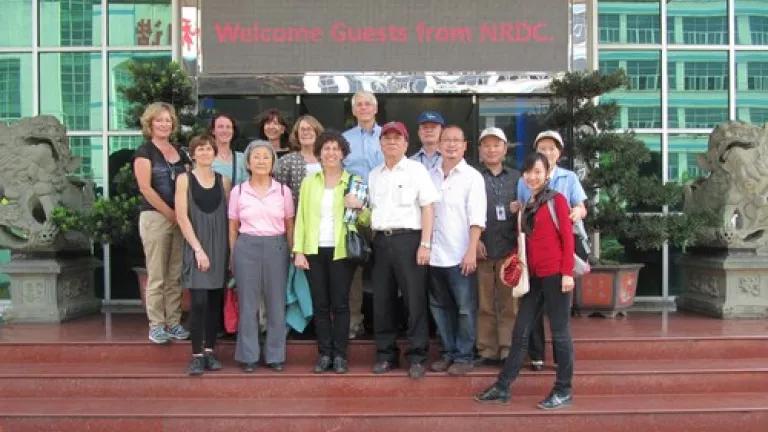
I'm writing from China this week, where NRDC has been working for more than fifteen years on energy and other environmental issues, and where we just opened our newest office – NRDC Hong Kong, China.
After the official launch of the new office, we traveled to Guangzhou, China’s second largest city and a major manufacturing center. Here I witnessed firsthand the results of NRDC’s Clean by Design initiative, which encourages U.S. retailers to work with their Chinese textile suppliers to reduce pollution and waste at their factories.
Half the clothing Americans buy is made in China, and much of it in Guangzhou, where the textile industry is one of the largest sources of water pollution. A single mill can pollute 200 tons of water for each ton of fabric it dyes, and the local rivers can change color according to the fashion of the moment, tainted with toxic chemicals.
The Chinese textile industry also creates about 3 billion tons of soot each year from burning coal for energy – and satellite photos show some of that pollution drifting right across the Pacific, as far as California.
Working with international experts, NRDC identified a number of ways that textile mills could reduce their water, energy, and chemical use while saving money. These are largely simple measures, such as insulating pipes, valves, and dye vats; recycling waste heat to pre-heat water; repairing steam leaks, and many related steps. What makes these measures so attractive to business is that they require minimal investment, and the payback time is usually less than a year.
We visited the Kam Hing Textile Dying and Knitting factory in Guangzhou, one China’s five biggest textile mills. Founded in 1997, Kam Hing produces 300,000 pounds of textiles each day, much of which it sells to major U.S. retailers – several of its clients participate in the Clean by Design initiative.
Kam Hing employs 5,000 people to spin and dye yarn, knit fabric (weaving fabric is apparently a very different process -- mills do one or the other but not both), and dye fabric. They are a huge operation, with 210 dying machines and 520 knitting machines. The dying is done at high temperature, using vast quantities of water and steam, and so is the focus of NRDC’s efficiency efforts. Drying uses 40 percent of the energy and is also very important.
Mr. Chau-lam Chong, Executive Director of Kam Hing, showed us around. He first took us to the testing area. Despite having grown up with textile manufacturing in the family – my grandfather and father were in the textile recycling business -- I was floored by all the tests they do on the cloth: checking the strength; how fast it degrades or changes color in light; abrasion resistance; how the color looks under different spectrum lights and in different temperature and humidity conditions; flammability; how well the colors stand up to washing (they have a room full of different sorts of washing machines and buckets of all the most common detergents of the world); and what chemicals leach out when the fabric is soaked in saliva.
Urged by its purchasers, and under pressure from the government because it was such a large energy consumer, Kam Hing opened its doors to NRDC and instituted a number of efficiency measures recommended by our experts, including insulating miles of pipe and other machines, recovering heat from hot rinse water, capturing condensate for reuse in dyeing vats, and more.
Overall, it was an impressive sight. If just 100 of China’s mills employed changes like these, the country would save more than 16 million metric tons of water annually, enough to provide 12.4 million people drinking water for a year. These measures could also eliminate nearly 1 million metric tons of CO2 annually – the equivalent of taking 172,000 cars off the road.
Clean by Design, with its promise of cost savings and a bit of pressure from important clients, could be the extra prod that revolutionizes the textile industry in China. While the Chinese government has regulations that require the cleanup of waste water and flue exhaust, and new national targets for reducing water use per unit of industrial product, enforcing these rules has proven to be a challenge (that’s another issue NRDC is working on in China). To really get change, perhaps a three-pronged approach is necessary: saving money, government regulation, and purchaser pressure.
